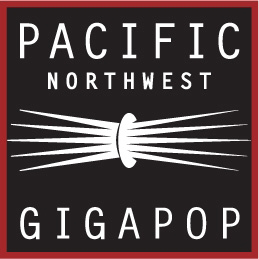The Corporation for Education Network Initiatives in California (CENIC) and Pacific Northwest Gigapop (PNWGP) today announced the expansion of the TransitRail national commodity peering program with the activation of a connection point in Ashburn, VA. The first TransitRail node to be activated east of the Mississippi, the Ashburn node has been put into service ahead of schedule and will soon be joined by a fifth node in Chicago, IL.
Read MoreWhat does a major regional research & education network do when it must continue to affordably meet the burgeoning demand for commodity Internet bandwidth? In the case of OneNet--Oklahoma's telecommunications and information network for education and government--the answer was to connect to TransitRail, a reliable, extensive commodity peering initiative designed to support the research and education networking community.
Read MorePacific Northwest Gigapop (PNWGP) was a key sponsor of the Lariat Summit Workshop titled "Shaping the Future of the West: Technology, Geography, and Technology Connecting Minority-Serving Institutions to US Advanced Cyberinfrastructure", which took place August 14 - 15, 2006 at Montana State University in Bozeman, MT.
Read MoreTransLight/Pacific Wave and TransLight/Starlight are now directly connected through a 10Gigabit Ethernet lightpath connection. The connection, donated by Cisco Systems in support of the TransLight project, is deployed by National LambdaRail. TransLight/StarLight and TransLight/Pacific Wave are projects funded by the National Science Foundation under the International Research Network Connections (IRNC) Program of the Office of CyberInfrastructure.
Read MoreInternet2 today announced that an international team set a new Internet2 Land Speed Records (I2-LSR) in the IPv4 and IPv6 single and multi-stream categories. As an open and ongoing competition for the highest-bandwidth, end-to-end networks, Internet2 LSR awards represent the fastest rate at which data is transferred multiplied by the distance traveled.
Read MoreFive NLR Members Begin Project to Improve Network Performance and Reduce Costs of Internet Services
Read MoreThe University of Idaho’s reputation for leadership in information technology just got a huge boost. Today, the university announced that, effective immediately, it has a direct on-ramp to the world's information highway with a new high-speed, fiber-optic, 2.4 gigabits-per-second network connection. The university previously had only 45 megabits-per-second of bandwidth.
Read MoreConnection Enables K20 Students Across the State to Participate in Leading-Edge Internet-Based Educational Opportunities
Read MoreInternet2 today announced that an international team set a new Internet2 Land Speed Records (I2-LSR) in both the IPv6 and IPv4 single and multi-stream categories. This record marks the
fourth time a University of Tokyo-lead team has achieved an Internet2 Land Speed record. As an open and ongoing competition for the highest-bandwidth, end-to-end networks, Internet2 LSR awards represent the fastest rate at which data is transferred multiplied by the distance traveled.
For the first time ever in a real-world environment, Pacific Northwest Gigapop (PNWGP) and its strategic partners have brought together more than one-half terabit per second (i.e., 500 gigabits per second) of bandwidth in deploying SCinet, the very high performance network built to support Supercomputing 2005 (SC¦05) in Seattle. The network is provisioned through multiple dark fiber strands brought by the University of Washington from the convention center to major telecommunications facilities in the city.
Read MoreWIDE Project, on September 21 succeeded in an experiment to perform a remote jazz jam session between Japan and Europe linking an event site at EXPO 2005 Aichi and SARA in Amsterdam, the Netherlands using uncompressed HDTV video imagery. The jazz session incorporated one of the research themes of the next generation Internet, Light Path, and was conducted with the cooperation of numerous global research and development networks including IEEAF, PNW Gigapop, CA*net4, MANLAN and SURFnet. Provisioned Light Paths were established between Japan and Europe and were used to transmit the uncompressed HDTV video streams. These extremely high-quality video images were used to present the live performance of jazz musicians at the EXPO Dome and the Netherlands.
Read MoreThe Pacific Northwest Gigapop is now enabled for native IPv6 traffic.
Read MoreIn a message from PRAGMA's Steering Committee Chair Peter Arzberger, Jacqueline Brown, PNWGP's Executive Director for International Partnerships, learned that the committee unanimously approved PNWGP's application for institutional membership on May 4, 2005 at the PRAGMA 8 Workshop in Singapore. Brown and Jim DeRoest, Director of Streaming Media Technologies for the University of Washington and the ResearchChannel, attended the PRAGMA 8 Workshop.
Read MoreUniversity of Tokyo Team Set New Performance Threshold for Long-Distance Data Transfer Using IPv4; Caltech and CERN Team Set New Mark Using Next Generation Internet Protocol
Read MoreJapans JGN2 Symposium 2005 Features Keynote Speaker Larry Smarr of UCSD Broadcast Live from Seattle over Advanced Optical Networks
Read MoreNine organisations from four countries, with AARNet, Australia's Academic & Research Network, providing a coordinating role, were involved in the successful electronic transfer to the Netherlands of data collected by Australian telescopes from the Huygens space probe as it plunged through the clouds of Titan on 14 January 2005.
Read MoreThe University of Hawaii has demonstrated Hawaii's first 10Gbps (billions of bit per second) connection outside the State. The new link, which connects Hawaii to Australia and the U.S. mainland, is part of the SX TransPORT project, a partnership between the Southern Cross Cable Network (SCCN) and AARNet, Australia's Academic and Research Network.
Read MoreAARNet (Australia's Academic and Research Network) and ResearchChannel today demonstrated the first high definition uncompressed interactive video interaction across the Pacific at 1.4 gigabits per second in each direction.
Read MoreEngineers in Japan, Canada, United States, The Netherlands, and CERN Switzerland completed the worlds longest native 10Gigabit Ethernet circuit for the transmission of data from the Japanese Data Reservoir project to the CERN research center in Geneva, Switzerland. The length of this light path is approximately 18,500 km and spans 17 time zones.
Read More